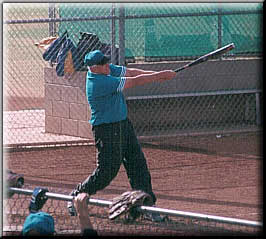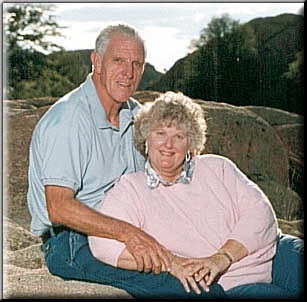“Don’t Give Up!”
Jerry and Nancy Sheehy have three words for anyone dealing with mesothelioma: "DON'T GIVE UP". And after all they have been through, this is not cheap advice.
In late 1998, Jerry, who was then 66, felt the "blahs," had shortness of breath, and couldn't run the bases in his two games per week softball league. Asking, "Why can't I breathe?" he went to his general practitioner, was diagnosed with pneumonia, and put on antibiotics. After 10 days with no improvement, his doctor took an x-ray which showed fluid on Jerry's left side. In November, he was sent to a pulmonary specialist who ran a number of tests, drained a large amount of fluid from Jerry's pleural space, and then did a biopsy.
The pulmonary specialist sat Jerry down and told him he had mesothelioma. Jerry was also told mesothelioma was extremely rare, there was no cure, no treatment, and not even chemotherapy would help. Rather than trying anything, he should just go home and get his affairs in order.
Jerry and Nancy were devastated. Jerry openly describes the grief stages he went through. He was devastated, then angry, then he cried "why me?" and then he cried "poor me." It took awhile, but finally he was able to say to himself, "O.K., I've got mesothelioma. Crying is not going to help. What am I going to do about it?"
Through their daughter, who is internet savvy, Jerry and Nancy began to search and research. They found Dr. David Jablons at the University of California at San Francisco Medical School. Dr. Jablons told Jerry he was a prime candidate for surgery, a pneumonectomy to remove Jerry's left lung and the tumor along with it. The surgery was scheduled, but then Jerry hit another dead end. Dr. Jablons found a nodule on Jerry's right lung. Jerry was disqualified from the surgery since, with his right lung now at risk, he could not afford to have his left lung removed.
Jerry and Nancy found a doctor in San Diego, but he agreed with Dr. Jablons that surgery was not an option. They then returned to Arizona and saw a doctor in Scottsdale. He suggested a second biopsy. This biopsy confirmed the bad news, when the doctor told Jerry and Nancy he was 100% sure it was mesothelioma. A talc-pleuradesis was recommended. But Jerry could not connect with the doctor to get an appointment for this procedure. Feeling precious time wasting, Jerry and Nancy moved on in their search.
In Sedona, Arizona, nearer to their home, they found Dr. Deborah Lindquist, an oncologist. Jerry describes Dr. Lindquist as different from the other doctors he had dealt with. "She makes suggestions, but listens to me and is open to what I want." This was important, because it allowed Jerry to feel more in control of his treatment and his condition. By this time, Jerry and Nancy had done a lot of studying, and, as they say, "had become their own experts." At the suggestion of Dr. Lindquist, they decided they wanted to try chemotherapy, even though Jerry's first doctor had said it wouldn't help.
In April 1999, Jerry began his first round of chemotherapy, with Cisplatin and Gemcytabine (Gemzar). The treatment almost killed him. For ten days, he was absolutely miserable, with diarrhea, vomiting and pain all over. (Jerry says the only side effect he didn't experience is that he did not lose his hair.) He told Dr. Lindquist that he'd rather die than continue the treatment. But in her quietly reassuring way, Dr. Lindquist said, "Don't give up. Let's try something else."

Dr. Lindquist recommended trying chemotherapy of one half-dose of Gemzar alone. Jerry did, and found that the side effects were practically non-existent. So Jerry continued on Gemzar alone for a year and a half, three weeks on and one week off. During this period, Jerry had to have fluid drained from his chest on two other occasions. But the tumor did not grow.
During this time, Jerry and Nancy continued to study, to pray and to listen to their hearts. They learned that Lovastatin, which is used primarily to reduce high cholesterol, had also been found in some cases to retard tumor growth. So they talked to Dr. Lindquist about trying this, and she agreed.
Jerry has been on Lovastatin, in conjunction with his chemotherapy, since May 1999. His tumor appears to have stabilized, and in May of 2000 his chemotherapy regimen was reduced to every other week. Of his only side effect -- tiredness -- Nancy says, "We'll take it. We are living a good life, and feel so very blessed to have had this time to zero in on what matters most in our lives." Jerry has even rejoined his two games per week softball league.
Jerry and Nancy Sheehy have been tested. Despite setbacks and dead ends, they have forged their own way. And after having been told, "Go home and get your affairs in order," Jerry is coming up on two years of survival. The lessons they have learned have not come cheap, but Jerry and Nancy are willing to share freely. Their message is, "Don't listen to anyone who says, 'Nothing can be done.' Study, study, study and listen to your heart. Find an oncologist who is open to most anything and will listen to you and your needs. Never lose hope, and DON'T GIVE UP."
*** POSTED SEPTEMBER 20, 2000 ***
Update from Nancy - 12/20/00
Because you all care about Jerry, I would like to let you know about his progress. Jerry was experiencing trouble breathing and it was discovered by a cat-scan that another tumor was growing in the right lung. (The original mesothelioma was in the left lung and we had experienced remission). A bronchoscopy was done to see if the tumor was pressing on the windpipe and also biopsies were taken. It was diagnosed that the new tumor was a different kind of cancer (a mutation of the meso) and had grown to 7.5 cm in two months. (This mutation is very common, we are told) We changed chemo treatments to Taxol and Carboplatin. Still Jerry was having trouble breathing, so we went to the ER. Another cat-scan was taken and the next day, after experiencing a bad night, the oncologist told us that the report of the scan showed that the tumor had grown, in spite of the chemo, and that this was not good and we should call hospice. His tumor is placed where the oxygen supplies the lungs. He has been in hospice for two weeks and it has been a god-send. Jerry is on morphine, so he is not experiencing any pain. He is also on oxygen. He is not giving up, but he is at peace. There is no prognosis at this time, simply because this tumor is so erratic and unpredictable. My heart is broken. We have been together almost 38 years, and it is still not enough time together. Please keep us in your prayers.
God Bless, Nancy
*** POSTED DECEMBER 27, 2000 ***
Mr. Jerry Sheehy passed away on February 15, 2001


